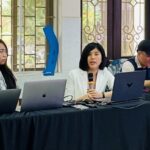The panel discussion featured three presentations with the following themes: “Rebuilding Industrial Heritage: From Evaluation to Management and Innovation” (Dr. Arch. Dinh Thi Hai Yen), “Villages in Relation to Development Projects in the Suburbs of Hanoi” (MSc. Arch. Pham Thuy Linh), and “Renovation and Preservation of Old Collective Housing Areas in Hanoi from an Urban Heritage Perspective” (MSc. Arch. Nguyen Viet Ninh).
On the morning of November 23, at the Gia Lam Locomotive Factory Auditorium, Hanoi Architectural University organized a panel discussion on “Rebuilding Heritage in the Heart of Hanoi: Approaches to Creative Exploitation and Value Enhancement.” This event is part of the Hanoi Creative Design Week 2023.
Opening the panel discussion, Assoc. Prof. Dr. Vuong Hai Long, Head of the Faculty of Architecture at Hanoi Architectural University, shared insights. Hanoi boasts numerous factories and enterprises, and over time, many of them have lost their original functions and tangible values. However, this doesn’t mean these structures have become valueless in a non-material sense. Each of these buildings encapsulates a timeline and holds historical, cultural, and artistic value. In the process of urban development, we must consider how to treat these structures culturally and humanely to create an urban depth, a continuous flow over time, ensuring the city has a “length” and isn’t merely a youthful, memoryless urban space. The theme of today’s discussion is pressing because Hanoi has numerous factories and enterprises that once served production needs. With urbanization, these factories have relocated from the city center. These factories and enterprises occupy prime locations in the city center. If we were to demolish these structures outright, it would be a significant waste and a disregard for industrial heritage. The redevelopment of industrial heritage is not a new issue; advanced countries worldwide have reasonably revitalized these structures to meet the demands of modern life while preserving heritage. These are lessons that Hanoi can learn from. In today’s panel discussion, there will be presentations from speakers to provide additional perspectives, insights, and resources for protecting, preserving, and enhancing the value of industrial heritage in the capital.
The panel discussion featured three presentations with the following themes: “Rebuilding Industrial Heritage: From Evaluation to Management and Innovation” (Dr. Arch. Dinh Thi Hai Yen), “Villages in Relation to Development Projects in the Suburbs of Hanoi” (MSc. Arch. Pham Thuy Linh), and “Renovation and Preservation of Old Collective Housing Areas in Hanoi from an Urban Heritage Perspective” (MSc. Arch. Nguyen Viet Ninh).

Dr. Arch. Dinh Thi Hai Yen
According to Dr. Arch. Dinh Thi Hai Yen, “In the context of constant urban dynamics and development, old industrial structures are not only conservation subjects but also cultural foundations, driving economic development. The adaptation and conversion of old industrial structures in the urban spatial structure of Hanoi’s inner city must be implemented through suitable methods to ensure both immediate needs and the city’s long-term development goals are met.”

MSc. Arch. Pham Thuy Linh
For MSc. Arch. Pham Thuy Linh, villages are an integral part of Hanoi’s heritage. The village’s heritage can be categorized into three groups based on their function and spatial transformations. Some have seamlessly integrated into modern life, some have partially adapted, while others remain incompatible. Adaptive heritage, such as ritual and religious heritage, endures; partially adaptive heritage, like traditional housing, exists but requires adjustments; non-adaptive heritage, including public spaces, agricultural land, ponds, and lakes, disappears. This indicates that heritage, depending on its adaptability to the new context, either vanishes or continues to coexist intermittently within the village and new urban spaces. The question is how to preserve the cultural-architectural value of the village in relation to other urban development projects.

MSc. Arch. Nguyen Viet Ninh
The exploration of old collective housing areas is the focus of MSc. Arch. Nguyen Viet Ninh’s research. According to Nguyen Viet Ninh, these areas harbor various values: historical, architectural art, technical-technological, cultural-social, and utilitarian values. In the flow of modern life, with the emergence of many high-rise buildings and new residential areas, how can we pose and answer the question of preserving and leveraging these values?

Overview of the panel discussion
The panel discussion’s presentations demonstrated the speakers’ keen interest and thorough research. The content was diverse, addressing topics that captivated the audience’s attention. Following the presentations, the speakers took time to engage with and exchange ideas with the audience at the Gia Lam Locomotive Factory Auditorium.
Ngoc Minh

